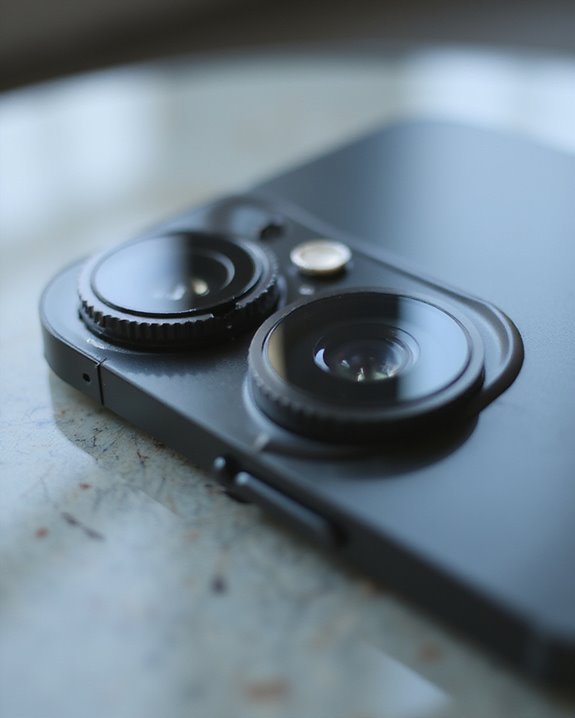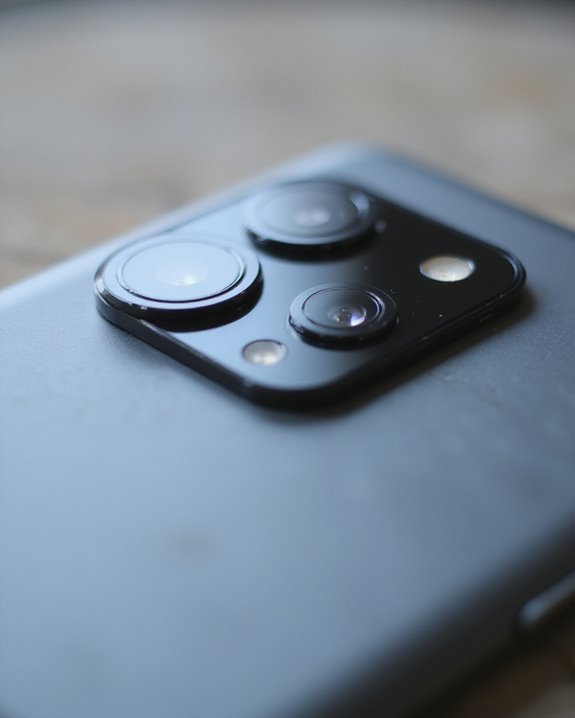The iPhone 12 series employs advanced camera lenses, starting with the base model’s 12-megapixel single-lens system featuring a 7-element design and f/1.6 aperture, which captures 27% more light and includes optical stabilization for reduced blur. Pro variants upgrade to dual-lens configurations with a 12-megapixel ultrawide lens at f/2.4 aperture and 120-degree field of view, while triple-lens setups add a 12-megapixel telephoto lens with 2x optical zoom and LIDAR for faster autofocus. These systems enhance image quality through Deep Fusion and Night mode, with performance metrics like improved dynamic range and noise reduction ensuring precise results; sensor details expand in the following analysis.
Key Takeaways
- The iPhone 12 features a 12-megapixel main camera with a 7-element lens and f/1.6 aperture.
- It includes a 12-megapixel ultrawide camera with f/2.4 aperture and 120-degree field of view.
- Deep Fusion technology enhances texture, detail, and noise reduction on both lenses.
- Optical image stabilization on the main camera helps reduce blur during shots.
- The main lens supports improved depth effects and bokeh for better portraits.
Iphone 12 Single-Lens Camera Systems
The iPhone 12’s single-lens camera system, centered on its primary 12-megapixel main camera, delivers enhanced photographic capabilities through a 7-element lens and an f/1.6 aperture that captures 27 percent more light than previous models, thereby improving overall image quality in varied lighting. The main camera, equipped with optical image stabilization, minimizes blur during photo and video capture, supporting up to 4K60 recording for superior resolution and fluidity. Deep Fusion technology, applied to the iPhone’s lens, analyzes multiple exposures to refine texture, detail, and noise reduction, enhancing performance in diverse conditions. Night mode on this main camera combines several frames, producing brighter, more detailed low-light images with reduced artifacts. As the iPhone’s core lens for everyday use, it prioritizes reliability, offering precise, high-fidelity results through these technical advancements. Additionally, for maintaining optimal performance, users can opt for OEM lens replacement to address any damage and restore the camera’s original quality.
Iphone 12 Dual-Lens Camera Configurations
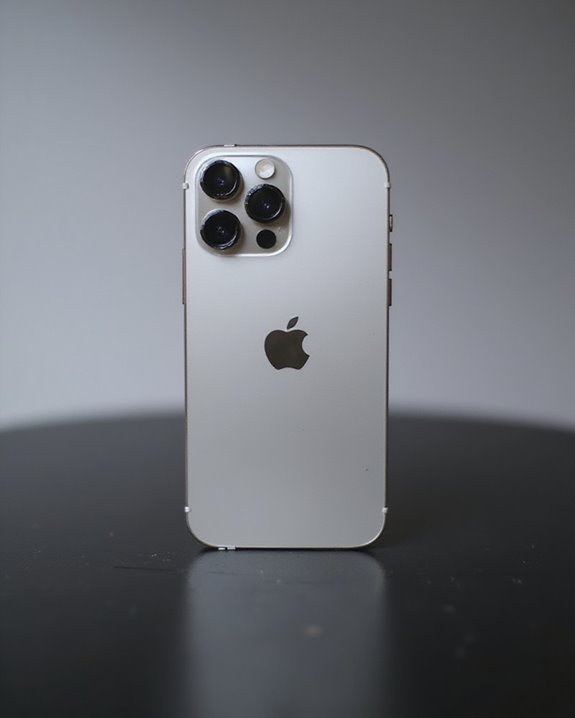
Iphone 12’s dual-lens camera configurations extend the device’s photographic versatility by incorporating a 12-megapixel main camera with a 7-element lens and an f/1.6 aperture that admits 27 percent more light than predecessors, alongside a 12-megapixel ultrawide camera featuring an f/2.4 aperture and a 120-degree field of view, equivalent to a 13mm focal length for capturing expansive scenes. The Ultrawide Camera enhances landscape photography through its 120-degree angle, supporting Night mode for automatic exposure adjustments in low-light conditions. Deep Fusion technology, applied to both lenses, optimizes computational processing to minimize noise and sharpen details, resulting in superior image quality. Smart HDR 3 further refines outputs by dynamically balancing white balance, contrast, and dynamic range, ensuring realistic representations across varying lighting, as evidenced by its advanced algorithmic enhancements that outperform earlier iterations in detail retention and exposure accuracy. Additionally, users can enhance the iPhone 12’s capabilities with external lens kits that offer accessories like wide-angle and macro options for greater creative flexibility.
Iphone 12 Pro Triple-Lens Camera Features
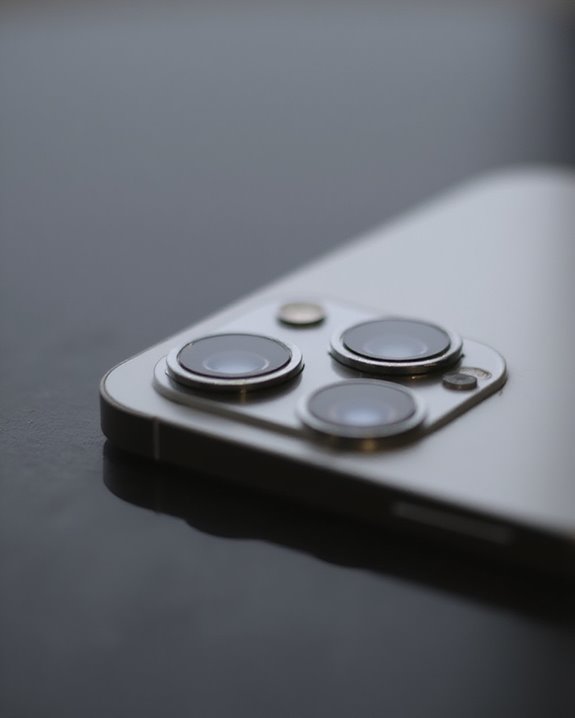
Enhancing the iPhone 12 Pro’s imaging prowess, its triple-lens camera system comprises a 12-megapixel wide lens with an f/1.6 aperture for superior low-light capture, a 12-megapixel ultrawide lens featuring an f/2.4 aperture and 120-degree field of view to encompass broader scenes, and a 12-megapixel telephoto camera with an f/2.0 aperture and 52mm equivalent focal length, enabling 2x optical zoom that extends to 10x digital zoom for detailed distant subjects. The ultrawide lens excels in capturing expansive landscapes, while the telephoto camera enhances subject isolation through precise zoom capabilities. Additionally, the LIDAR sensor improves autofocus speed up to 6x in low-light, supporting Night mode across all lenses for brighter images and Deep Fusion technology for noise reduction and texture optimization, ensuring overall superior photo quality with minimal artifacts. This configuration delivers versatile, high-fidelity results. For users seeking to extend the telephoto capabilities further, external attachments like the 30X Telephoto Lens can provide up to 30X magnification for enhanced distant subject capture.
Main and Ultrawide Lens Details
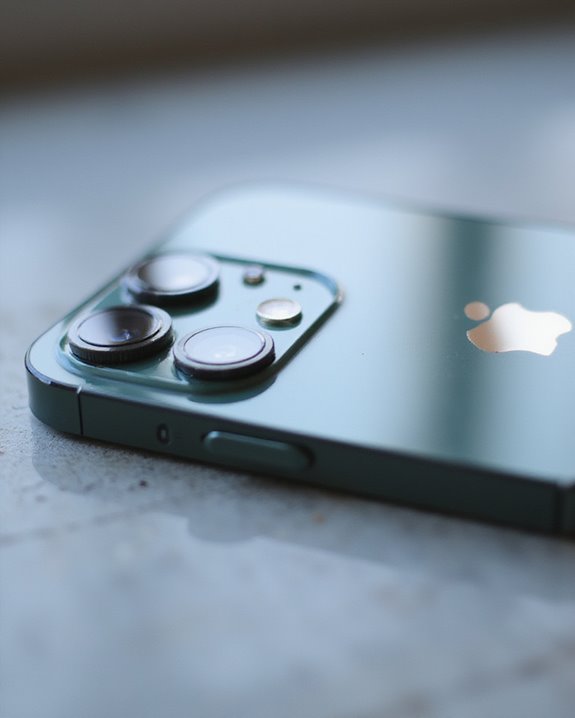
Central to the iPhone 12’s camera system, the main and ultrawide lenses deliver enhanced imaging performance through their 12-megapixel sensors, with the main lens incorporating a 7-element design and f/1.6 aperture that captures 27 percent more light than predecessors for superior low-light scenarios, while the ultrawide lens features an f/2.4 aperture and 120-degree field of view, equivalent to a 13mm focal length, to minimize distortion in expansive wide-angle photography. The main and ultrawide cameras integrate Deep Fusion technology, which refines image processing by enhancing texture, detail, and noise reduction across lighting conditions. Additionally, Night mode activates on both lenses, extending exposure for brighter, detailed low-light captures. The main camera’s f/1.6 aperture supports improved depth and bokeh effects, whereas the ultrawide camera’s 13mm focal length guarantees precise, distortion-free wide scenes, promoting overall imaging versatility.
Telephoto Lens Enhancements

The telephoto lens in the iPhone 12 Pro series, featuring a 12-megapixel sensor, provides advanced optical capabilities that extend beyond those of earlier models, with a 52mm-equivalent focal length on the iPhone 12 Pro delivering 2x optical zoom and up to 10x digital zoom for clearer distant imagery, while the iPhone 12 Pro Max upgrades this to a 65mm-equivalent focal length with 2.5x optical zoom and an f/2.2 aperture that improves low-light performance by capturing more light. This telephoto lens, enhanced by LIDAR for 6x faster autofocus in dim conditions, guarantees precise focusing and sharper zoomed shots. Optical zoom capabilities enable detailed distant captures, while Deep Fusion optimizes noise and texture. Night Mode integration on the telephoto lens facilitates brighter, stabilized low-light photography, enhancing overall image quality through better light exposure and reduced blur. These features collectively elevate telephoto performance for professional-grade results.
Frequently Asked Questions
Why Are There Two Lenses on Iphone 12?
Ironically, in an age where simplicity reigns, the iPhone 12’s two lenses address why such duplication exists: advancing camera evolution through lens purpose for versatile shots, while design benefits enhance light intake and image quality.
What Are the 3 Different Lenses on Iphone?
Addressing the current question about the three different lenses on the iPhone, Lens Identification in Camera Specifications reveals a wide lens, an ultrawide lens, and a telephoto lens as key Optical Elements. These provide varied focal lengths, apertures, and zoom capabilities for enhanced photography.
How Do I Use Different Lenses on My Iphone 12?
Using different lenses on the iPhone 12 involves lens switching in the Camera app, such as selecting 0.5x for ultrawide or 1x for wide. Manual focus adjustments and exposure control features allow users to refine shots, enhancing composition and low-light performance.
Is the Telephoto Lens on Iphone Worth It?
While some may object to the telephoto lens’s added cost, its Lens Value shines through Zoom Benefits like 2x optical zoom, proving Cost Effectiveness by enhancing low-light shots and distant details for superior iPhone photography.

